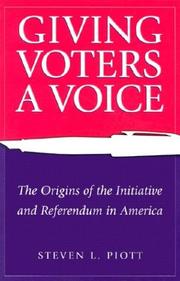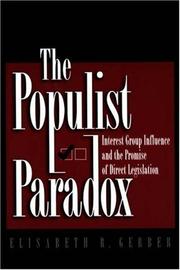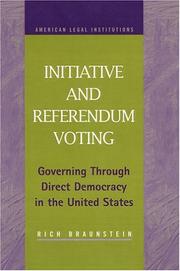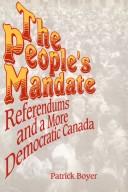| Listing 1 - 10 of 102 | << page >> |
Sort by
|
Book
ISSN: 05244544 ISBN: 8322921772 Year: 2001 Volume: 2331 CCLXXIV Publisher: Wrocław Wydawnictwo uniwersytetu Wrocławskiego
Abstract | Keywords | Export | Availability | Bookmark
 Loading...
Loading...Choose an application
- Reference Manager
- EndNote
- RefWorks (Direct export to RefWorks)
Referendum --- -Ballot initiatives --- Ballot measures --- Initiative and referendum --- Initiatives, Ballot --- Propositions (Referendum) --- Referenda --- Referendums --- Democracy --- Elections --- Representative government and representation --- Direct democracy --- Plebiscite --- -Referendum --- Ballot initiatives --- Poland
Book
ISBN: 9516489346 Year: 1983 Publisher: Aabo : Åbo akademis förlag = Åbo akademi university press,
Abstract | Keywords | Export | Availability | Bookmark
 Loading...
Loading...Choose an application
- Reference Manager
- EndNote
- RefWorks (Direct export to RefWorks)
Referendum --- Ballot initiatives --- Ballot measures --- Initiative and referendum --- Initiatives, Ballot --- Propositions (Referendum) --- Referenda --- Referendums --- Democracy --- Elections --- Representative government and representation --- Direct democracy --- Plebiscite --- Finlande --- Politique et gouvernement

ISBN: 0826263399 9780826263391 0826214576 9780826214577 Year: 2003 Publisher: Columbia, Mo. University of Missouri Press
Abstract | Keywords | Export | Availability | Bookmark
 Loading...
Loading...Choose an application
- Reference Manager
- EndNote
- RefWorks (Direct export to RefWorks)
Giving Voters a Voice studies the origins of direct legislation, one of the most important political reforms enacted during the Progressive Era. Steven L. Piott begins with the source of the idea in the United States and proceeds to the earliest efforts aimed at generating a national movement to expand the parameters of popular democracy in the 1890s. He then broadens his examination to include the unique ways in which twenty-two states came to enact legislation allowing for the statewide initiative and referendum between 1898 and 1918. The book's appendix offers the only comprehensive listing of all the ballot propositions and vote totals for the period. Most historians of the Progressive Era have concluded that narrow self-interest prevented labor, farmers, and the middle class from working together to achieve important reforms. Giving Voters a Voice demonstrates that middle-class reformers, trade unionists, and farm organizers formed loose political coalitions and directed grass-roots campaigns to gain passage of initiative and referendum statutes because direct legislation offered the best means to correct political, economic, and social abuses. But there was more than just a shared sense of common interest that brought these seemingly oppositional groups together. What really made them willing to speak, lobby, and work together was quite simply the frustration felt by voters who sensed that they had become economically dependent and politically powerless. Each state in which proponents conducted an active campaign to win adoption of direct legislation is studied in detail. The book analyzes the crucial roles played by individuals who led the movement to empower voters by enabling them to enact or veto legislation directly, and reveals the arguments, the stumbling blocks, and political compromises that are often slighted in generalized overviews. Each state possessed its own political dynamic. Giving Voters a Voice offers the reader a richness of detail and a completeness of coverage not found elsewhere.
Referendum --- Ballot initiatives --- Ballot measures --- Initiative and referendum --- Initiatives, Ballot --- Propositions (Referendum) --- Referenda --- Referendums --- Democracy --- Elections --- Representative government and representation --- Direct democracy --- Plebiscite --- History.

ISBN: 1400823307 9786613339713 1400811724 1283339714 9781400823307 0691002665 0691002673 9780691002675 Year: 2011 Publisher: Princeton Princeton University Press
Abstract | Keywords | Export | Availability | Bookmark
 Loading...
Loading...Choose an application
- Reference Manager
- EndNote
- RefWorks (Direct export to RefWorks)
Do small but wealthy interest groups influence referendums, ballot initiatives, and other forms of direct legislation at the expense of the broader public interest? Many observers argue that they do, often lamenting that direct legislation has, paradoxically, been captured by the very same wealthy interests whose power it was designed to curb. Elisabeth Gerber, however, challenges that argument. In this first systematic study of how money and interest group power actually affect direct legislation, she reveals that big spending does not necessarily mean big influence. Gerber bases her findings on extensive surveys of the activities and motivations of interest groups and on close examination of campaign finance records from 168 direct legislation campaigns in eight states. Her research confirms what such wealthy interests as the insurance industry, trial lawyer associations, and tobacco companies have learned by defeats at the ballot box: if citizens do not like a proposed new law, even an expensive, high-profile campaign will not make them change their mind. She demonstrates, however, that these economic interest groups have considerable success in using direct legislation to block initiatives that others are proposing and to exert pressure on politicians. By contrast, citizen interest groups with broad-based support and significant organizational resources have proven to be extremely effective in using direct legislation to pass new laws. Clearly written and argued, this is a major theoretical and empirical contribution to our understanding of the role of citizens and organized interests in the American legislative process.
Pressure groups --- Referendum --- Ballot initiatives --- Ballot measures --- Initiative and referendum --- Initiatives, Ballot --- Propositions (Referendum) --- Referenda --- Referendums --- Democracy --- Elections --- Representative government and representation --- Direct democracy --- Plebiscite

ISBN: 1593321023 9781593321024 9781593320409 159332040X Year: 2004 Publisher: New York LFB Scholarly Pub.
Abstract | Keywords | Export | Availability | Bookmark
 Loading...
Loading...Choose an application
- Reference Manager
- EndNote
- RefWorks (Direct export to RefWorks)
Referendum --- Direct democracy --- Direct legislation --- Democracy --- Ballot initiatives --- Ballot measures --- Initiative and referendum --- Initiatives, Ballot --- Propositions (Referendum) --- Referenda --- Referendums --- Elections --- Representative government and representation --- Plebiscite

ISBN: 9786611962098 155488344X 1281962090 1282808915 9786612808913 1770700676 9781554883448 1550021478 9781550021479 Year: 1992 Publisher: Toronto [Ont.] Dundurn Press
Abstract | Keywords | Export | Availability | Bookmark
 Loading...
Loading...Choose an application
- Reference Manager
- EndNote
- RefWorks (Direct export to RefWorks)
A mood of anger with the political system has been stirring across Canada; yet rather than turning away from the system, many Canadians are actually seeking a greater say in matters that affect them. they want to become more effective participants in the political process. In this timely book, Patrick Boyer examines the important role that direct democracy -- through the occasional use of referendums, plebscites, and inniatives -- can play in concert with our existing institutions of representative democracy. This concept is not alien to our country, says Boyer, pointing to th
Referendum --- Ballot initiatives --- Ballot measures --- Initiative and referendum --- Initiatives, Ballot --- Propositions (Referendum) --- Referenda --- Referendums --- Democracy --- Elections --- Representative government and representation --- Direct democracy --- Plebiscite
Book
ISBN: 1438453396 9781438453392 143845337X 9781438453378 9781438453378 Year: 2014 Publisher: Albany, New York
Abstract | Keywords | Export | Availability | Bookmark
 Loading...
Loading...Choose an application
- Reference Manager
- EndNote
- RefWorks (Direct export to RefWorks)
The initiative is the product of the populist movement, which in the late nineteenth century sought to increase voter control of what were viewed as unrepresentative state and local governments. Today, twenty-four states allow registered voters to place proposed state laws on the referendum ballot, and eighteen states authorize voters to place proposed state constitutional amendments on the referendum ballot by collecting a specified number of valid voter signatures. Numerous local governments have a charter provision or a state law provision allowing voters to employ the popular lawmaking device. In The Initiative, Second Edition, Joseph F. Zimmerman traces the origin and spread of the initiative in the United States. The initiative has been a controversial device since first being introduced in South Dakota in 1898, with arguments both in support and in opposition. Zimmerman examines and evaluates both the legal foundation of the initiative, and the arguments against its use. He then concludes with a chapter that develops model constitutional, statutory, and local government charter provisions to assist jurisdictions and their voters contemplating adoption of the initiative or amendment of already existing constitutional, statutory, and charter initiative provisions.
Referendum --- Ballot initiatives --- Ballot measures --- Initiative and referendum --- Initiatives, Ballot --- Propositions (Referendum) --- Referenda --- Referendums --- Democracy --- Elections --- Representative government and representation --- Direct democracy --- Plebiscite
Book
ISBN: 3030558037 3030558029 Year: 2021 Publisher: Cham, Switzerland : Springer,
Abstract | Keywords | Export | Availability | Bookmark
 Loading...
Loading...Choose an application
- Reference Manager
- EndNote
- RefWorks (Direct export to RefWorks)
Referendum. --- Ballot initiatives --- Ballot measures --- Initiative and referendum --- Initiatives, Ballot --- Propositions (Referendum) --- Referenda --- Referendums --- Democracy --- Elections --- Representative government and representation --- Direct democracy --- Plebiscite
Book
ISBN: 0192637789 0191904414 9780198867647 0192637797 0198867646 Year: 2022 Publisher: Oxford, UK : Oxford University Press,
Abstract | Keywords | Export | Availability | Bookmark
 Loading...
Loading...Choose an application
- Reference Manager
- EndNote
- RefWorks (Direct export to RefWorks)
Brings together diverse perspectives on referendums, constitutionalism, liberalism, and democracy in ways that challenge the conventional wisdom, prompt new answers to enduring questions, and urge reconsideration of how we evaluate the legitimacy of referendums.
Referendum. --- Democracy --- Elections --- Representative government and representation --- Direct democracy --- Plebiscite --- Ballot initiatives --- Ballot measures --- Initiative and referendum --- Initiatives, Ballot --- Propositions (Referendum) --- Referenda --- Referendums --- Référendum --- Referendum --- History.
Book
ISBN: 1108962637 1108955797 110884541X 1108958176 Year: 2023 Publisher: Cambridge, United Kingdom ; New York, NY : Cambridge University Press,
Abstract | Keywords | Export | Availability | Bookmark
 Loading...
Loading...Choose an application
- Reference Manager
- EndNote
- RefWorks (Direct export to RefWorks)
What are the limits to parliamentary sovereignty? When should the people be able to vote directly on issues? The constitutional theorist Albert Venn Dicey (1835-1922) was a cogent advocate of the referendum. While his enthusiasm for the institution was widely acknowledged in his own day, thereafter this dimension of his career has been largely neglected. This fall into obscurity is partly explained by the fact that Dicey never collected his writings on referendums into a single volume. Consequently, during the prolonged crisis over Brexit, the implications of Dicey's thought were unclear, despite his standing as a foundational figure in British constitutional law. This timely modern edition brings together Dicey's sophisticated and intricate writings on the referendum, and it covers his attempts to construct a credible theory of democracy on a new intellectual and institutional basis. An original scholarly introduction analyzes Dicey's thought in light of its contemporary context.
Representative government and representation --- Referendum --- Ballot initiatives --- Ballot measures --- Initiative and referendum --- Initiatives, Ballot --- Propositions (Referendum) --- Referenda --- Referendums --- Democracy --- Elections --- Direct democracy --- Plebiscite
| Listing 1 - 10 of 102 | << page >> |
Sort by
|

 Search
Search Feedback
Feedback About UniCat
About UniCat  Help
Help News
News